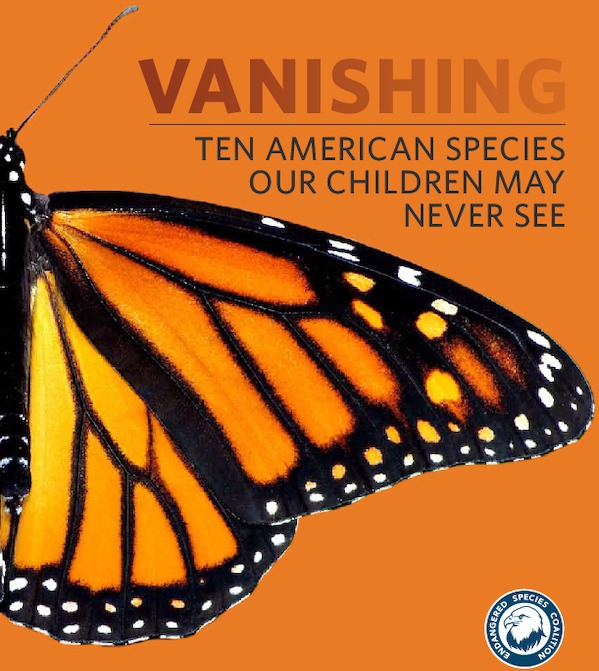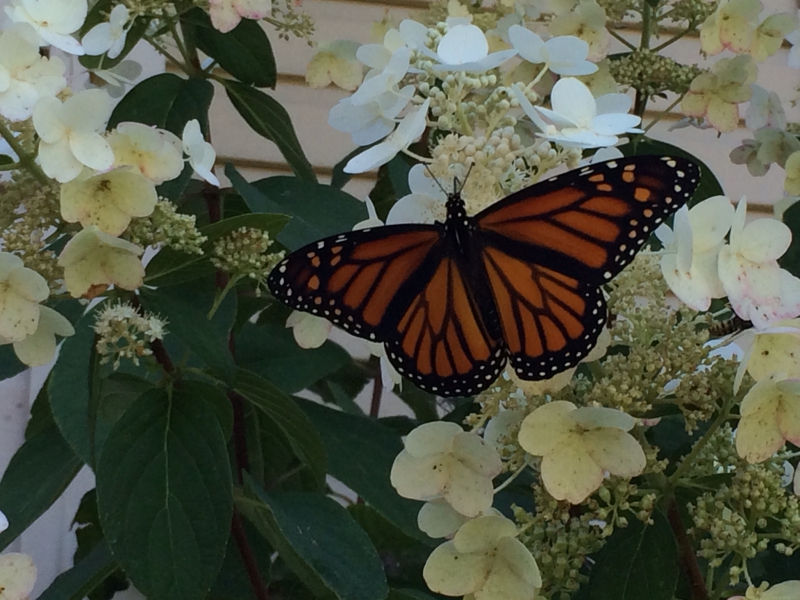From the Open-Publishing Calendar
From the Open-Publishing Newswire
Indybay Feature
New Report: Monarch Butterfly a Species Our Children May Never See
The monarch butterfly, whose spectacular 2,000-mile migration has captivated scientists and school students for generations, is disappearing largely due to pesticides and may not be around for our children to witness in the future, according to a new report (see PDF).
The monarch is one of 10 threatened species highlighted in the report, Vanishing: Ten American Species Our Children May Never See, by the Endangered Species Coalition, which comprises hundreds of national and local conservation groups, including the Center for Biological Diversity, Natural Resources Defense Council and Xerces Society for Invertebrate Conservation. The report identifies everyday actions that people can take to help slow the disappearance of our nation’s iconic wildlife. The report can be viewed and downloaded from the website vanishingwildlife.org.
NRDC, the Xerces Society and the Center for Biological Diversity have each launched efforts to save the monarchs, whose population has plummeted by more than 90 percent in large part because the heavy application of the weed killer glyphosate (initially marketed as RoundupTM) on genetically modified corn and soybeans has contributed to the decline of milkweed plants, which the monarchs need to survive.
“When species like monarch butterflies are in trouble, that means we’re all in trouble, because they’re leading indicators of the health of the planet,” said Frances Beinecke, president of NRDC. “By acting now to conserve these beautiful creatures for future generations, we will also be restoring our natural heritage and creating a safer, healthier world for all.”
“The monarch butterfly is a familiar backyard friend, and its drastic decline is a wakeup call that we’re spraying and paving our way to a lonely, less interesting and dangerously less diverse planet,” said Tierra Curry, a senior scientist at the Center for Biological Diversity.
“Restoring the monarch butterfly’s habitat will require a large-scale commitment to replant milkweed across the millions of acres from which it has been lost,” said Sarina Jepsen, endangered species director at the Xerces Society. “We have already seen leadership from some farmers to bring milkweed back into the landscape.”
“With each passing day, our children are less and less likely to experience the full beauty of nature and see the kind of wildlife that baby boomers, Gen Xers and even Millennials experienced,” said Leda Huta, executive director of the Endangered Species Coalition. “We owe it to our future generations of Americans to protect our vanishing wildlife and the special places they call home.”
The other species in the report are the whitebark pine, mountain yellow-legged frog, North Pacific right whale, great white shark, little brown bat, rusty patched bumble bee, greater sage-grouse, polar bear and Snake River sockeye salmon.
According to the report, up to a billion monarch butterflies used to color our skies each summer, yet only about 33 million now remain. NRDC earlier this year filed an emergency petition with the Environmental Protection Agency seeking restrictions on glyphosate. Its use on corn and soybeans has soared 20-fold since the introduction in the 1990s of genetically modified crops that are glyphosate resistant, enabling farmers to blanket their fields with the herbicide and destroy native milkweed. Separately, the Center for Biological Diversity and the Xerces Society, along with the Center for Food Safety and renowned monarch researcher Lincoln Brower, last month petitioned the U.S. Fish and Wildlife Service to list the monarch as a threatened species under the Endangered Species Act, which would allow significant protections for monarch habitat.
The organizations are also engaging in efforts to plant locally appropriate species of native milkweed along the monarchs’ main migration route, which stretches from a winter refuge in the mountains of Mexico through the eastern and Midwestern states up to southern Canada — as well as throughout western states for the population that primarily overwinters in California.
Coalition member groups nominated wildlife species in the report. The Center for Biological Diversity, NRDC and the Xerces Society each nominated the monarch; a committee of distinguished scientists reviewed the nominations and decided which species should be included in the report.
The Endangered Species Coalition has also produced a slide show to accompany the report, featuring stunning photos of each of the 10 species in the report. The coalition produces a “Top 10” report annually, focusing on a different theme each year. Previous years’ reports are also available on the coalition’s website.
The Center for Biological Diversity is a national, nonprofit conservation organization with more than 775,000 members and online activists dedicated to the protection of endangered species and wild places.
The Natural Resources Defense Council (NRDC) is an international nonprofit environmental organization with more than 1.4 million members and online activists. Since 1970, our lawyers, scientists, and other environmental specialists have worked to protect the world's natural resources, public health, and the environment. NRDC has offices in New York City, Washington, D.C., Los Angeles, San Francisco, Chicago, Bozeman, MT, and Beijing. Visit us at http://www.nrdc.org and follow us on Twitter @NRDC.
The Xerces Society for Invertebrate Conservation is a nonprofit organization that protects wildlife through the conservation of invertebrates and their habitat. For more than forty years, the Society has been at the forefront of invertebrate protection, harnessing the knowledge of scientists and the enthusiasm of citizens to implement conservation programs worldwide. Learn about our work at http://www.xerces.org.
http://www.biologicaldiversity.org/news/press_releases/2014/monarch-butterfly-09-23-2014.html
Center for Biological Diversity
http://www.biologicaldiversity.org/
NRDC, the Xerces Society and the Center for Biological Diversity have each launched efforts to save the monarchs, whose population has plummeted by more than 90 percent in large part because the heavy application of the weed killer glyphosate (initially marketed as RoundupTM) on genetically modified corn and soybeans has contributed to the decline of milkweed plants, which the monarchs need to survive.
“When species like monarch butterflies are in trouble, that means we’re all in trouble, because they’re leading indicators of the health of the planet,” said Frances Beinecke, president of NRDC. “By acting now to conserve these beautiful creatures for future generations, we will also be restoring our natural heritage and creating a safer, healthier world for all.”
“The monarch butterfly is a familiar backyard friend, and its drastic decline is a wakeup call that we’re spraying and paving our way to a lonely, less interesting and dangerously less diverse planet,” said Tierra Curry, a senior scientist at the Center for Biological Diversity.
“Restoring the monarch butterfly’s habitat will require a large-scale commitment to replant milkweed across the millions of acres from which it has been lost,” said Sarina Jepsen, endangered species director at the Xerces Society. “We have already seen leadership from some farmers to bring milkweed back into the landscape.”
“With each passing day, our children are less and less likely to experience the full beauty of nature and see the kind of wildlife that baby boomers, Gen Xers and even Millennials experienced,” said Leda Huta, executive director of the Endangered Species Coalition. “We owe it to our future generations of Americans to protect our vanishing wildlife and the special places they call home.”
The other species in the report are the whitebark pine, mountain yellow-legged frog, North Pacific right whale, great white shark, little brown bat, rusty patched bumble bee, greater sage-grouse, polar bear and Snake River sockeye salmon.
According to the report, up to a billion monarch butterflies used to color our skies each summer, yet only about 33 million now remain. NRDC earlier this year filed an emergency petition with the Environmental Protection Agency seeking restrictions on glyphosate. Its use on corn and soybeans has soared 20-fold since the introduction in the 1990s of genetically modified crops that are glyphosate resistant, enabling farmers to blanket their fields with the herbicide and destroy native milkweed. Separately, the Center for Biological Diversity and the Xerces Society, along with the Center for Food Safety and renowned monarch researcher Lincoln Brower, last month petitioned the U.S. Fish and Wildlife Service to list the monarch as a threatened species under the Endangered Species Act, which would allow significant protections for monarch habitat.
The organizations are also engaging in efforts to plant locally appropriate species of native milkweed along the monarchs’ main migration route, which stretches from a winter refuge in the mountains of Mexico through the eastern and Midwestern states up to southern Canada — as well as throughout western states for the population that primarily overwinters in California.
Coalition member groups nominated wildlife species in the report. The Center for Biological Diversity, NRDC and the Xerces Society each nominated the monarch; a committee of distinguished scientists reviewed the nominations and decided which species should be included in the report.
The Endangered Species Coalition has also produced a slide show to accompany the report, featuring stunning photos of each of the 10 species in the report. The coalition produces a “Top 10” report annually, focusing on a different theme each year. Previous years’ reports are also available on the coalition’s website.
The Center for Biological Diversity is a national, nonprofit conservation organization with more than 775,000 members and online activists dedicated to the protection of endangered species and wild places.
The Natural Resources Defense Council (NRDC) is an international nonprofit environmental organization with more than 1.4 million members and online activists. Since 1970, our lawyers, scientists, and other environmental specialists have worked to protect the world's natural resources, public health, and the environment. NRDC has offices in New York City, Washington, D.C., Los Angeles, San Francisco, Chicago, Bozeman, MT, and Beijing. Visit us at http://www.nrdc.org and follow us on Twitter @NRDC.
The Xerces Society for Invertebrate Conservation is a nonprofit organization that protects wildlife through the conservation of invertebrates and their habitat. For more than forty years, the Society has been at the forefront of invertebrate protection, harnessing the knowledge of scientists and the enthusiasm of citizens to implement conservation programs worldwide. Learn about our work at http://www.xerces.org.
http://www.biologicaldiversity.org/news/press_releases/2014/monarch-butterfly-09-23-2014.html
Center for Biological Diversity
http://www.biologicaldiversity.org/
Add Your Comments
Latest Comments
Listed below are the latest comments about this post.
These comments are submitted anonymously by website visitors.
TITLE
AUTHOR
DATE
People should hold their heads down in shame over this.
Wed, Sep 24, 2014 9:37AM
We are 100% volunteer and depend on your participation to sustain our efforts!
Get Involved
If you'd like to help with maintaining or developing the website, contact us.
Publish
Publish your stories and upcoming events on Indybay.
Topics
More
Search Indybay's Archives
Advanced Search
►
▼
IMC Network




